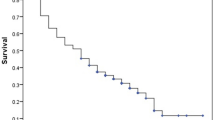Abstract
Survival analysis was used to model theretention of 8,867 undergraduate students at OregonState University between 1991 and 1996. Attrition wasfound to increase with age, and decrease with increasing high school GPA and first-quarter GPA.Non-residents had higher attrition rates than didresident and international students, and students takingthe Freshman Orientation Course appeared to be atreduced risk of dropping out. Statistically significantassociations of retention with ethnicity/race andcollege at first enrollment were also noted. Aproportional hazards regression model was developed topredict a student's probability of leaving school basedon these demographic and academic variables. Theseanalyses are helping to guide the university's effortsto improve retention through marketing, recruitment, and the development of orientation and otherprograms.
Similar content being viewed by others
REFERENCES
Anonymous (1997). Freshman-to-s ophomore persistence rates, 1983-1997. Postsecondary Education OPPORTUNITY, Number 60, pp. 1-7. The Mortenson Research Seminar on Public Policy Analysis of Opportunity for Postsecondary Education, Iowa City, Iowa.
Astin, A. W. (1993). What Matters in College: Four Critical Years Revisited. San Francisco: Jossey-Bass.
Avakian, A. N., MacKinney, A. C., and Allen, G. R. (1982). Race and sex differences in student retention at an urban university. College and University57: 160-165.
Bedford, M. H., and Durkee, P. E. (1989). Retention: Some more ideas. NASPA Journal27: 168-171.
Boudreau, C. A., and Kromrey, J. D. (1994). A longitudinal study of the retention and academic performance of participants in freshmen orientation course. Journal of College Student Development35: 444-449.
Breslow, N. E. (1974). Covariance analysis of censored survival data. Biometrics30: 89-99.
Cabrera, A. F., Nora, A., and Casta Äneda, M. B. 1993. College persistence: Structural equations modeling test of an integrated model of student retention. Journal of Higher Education64: 123-139.
Collett, D. (1994). Modelling Survival Data in Medical Research. New York: Chapman and Hall.
Cox, D. R. (1972). Regression models and life tables (with discussion). Journal of the Royal Statistical Society B34: 187-220.
Dey, E. L., and Astin, A. W. (1993). Statistical alternatives for studying college student retention: A comparative analysis of logit, probit, and linear regression. Research in Higher Education34: 569-581.
Dodd, J. M., Garcia, F. M., and Nelson, J. R. (1995). American Indian student retention. NASPA Journal33(1): 72-78.
Dougherty, R. C., Bowen, C. W., Berger, T., Rees, W., Mellon, E. K., and Pulliam, E. (1995). Cooperative learning and enhanced communication: Effects on student performance, retention, and attitudes in general chemistry. Journal of Chemical Education72(9): 793-797.
Glass, J. C., and Garrett, M. S. (1995). Student participation in a college orientation course, retention, and grade point average. Community College Journal of Research and Practice19: 117-132.
Harrell, F. E., Jr., Lee, K. L., and Mark, D. B. (1996). Multivariable prognostic models: Issues in developing models, evaluating assumptions and adequacy, and measuring and reducing errors. Statistics in Medicine15: 361-387.
Heiberger, R. M. (1993). Predicting next year' s enrollm ent: Survival analysis of university student enrollm ent histories. Proceedings of the American Statistical Association, Social Statistical Section, pp. 143-148.
Hyman, R. E. (1995). Creating campus partnerships for student success. College and University71: 2-8.
Johnson, R. (1996). The adult student: Motivation and retention. The American Music Teacher46(2): 16-18, 60-61.
Kalbfleisch, J. D., and Prentice, R. L. (1980). The Statistical Analysis of Failure Time Data. New York: Wiley.
Kaplan, E. L., and Meier, P. (1958). Nonparametric estimation from incomplete observations. Journal of the American Statistical Association53: 457-481.
Lawless, J. F. (1982). Statistical Models and Methods for Lifetime Data. New York: Wiley.
Lee, E. T. (1992). Statistical Methods for Survival Data Analysis. New York: Wiley.
Moore, R., and Miller, I. (1996). How the use of multimedia affects student retention and learning. Journal of College Science Teaching25(4): 289-293.
Naretto, J. A. (1995). Adult student retention: The influence of internal and external communities. NASPA Journal32: 90-97.
Person, D. R., and Christensen, M. C. (1996). Understanding black student culture and black student retention. NASPA Journal34(1): 47-56.
Peto, R., and Peto, J. (1972). Asymptotically efficient rank invariant procedures. Journal of the Royal Statistical Society, Series A135: 185-207.
Reyes, N. (1997). Holding on to what they' ve got. Black Issues in Higher Education13(26): 36-40.
Statistical Sciences Inc. (1993). S-Plus Statistical Software, User's ManualVersion 3.2. Seattle: Statistical Sciences Inc.
Tinto, V. (1993). Leaving College: Rethinking the Causes and Cures of Student Attrition. Chicago: The University of Chicago Press.
Volkwein, J. F., and Lorang, W. G. (1996). Characteristics of extenders: Full-time students who take light credit loads and graduate in more than four years. Research in Higher Education37: 43-68.
Rights and permissions
About this article
Cite this article
Murtaugh, P.A., Burns, L.D. & Schuster, J. PREDICTING THE RETENTION OF UNIVERSITY STUDENTS. Research in Higher Education 40, 355–371 (1999). https://doi.org/10.1023/A:1018755201899
Issue Date:
DOI: https://doi.org/10.1023/A:1018755201899




